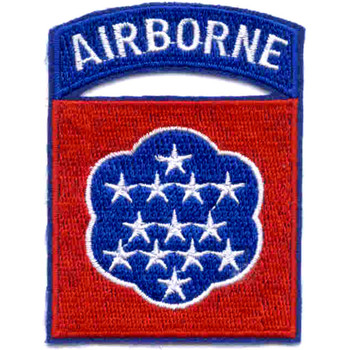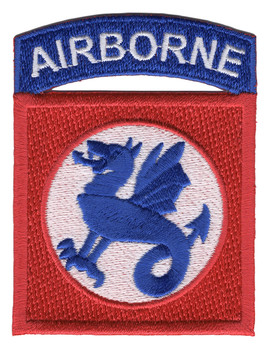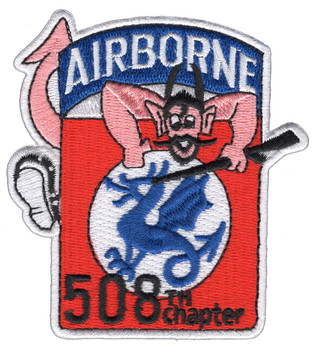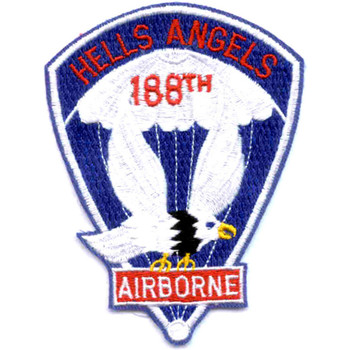Description
508th Airborne Infantry Regiment Patch Fury From The Sky Vietnam (U.S. Army) 2.75" x 3.5" Embroidered Patch with Iron-On Backing
Superior Materials: Made with premium polyester thread and durable twill fabric, ensuring long-lasting color and strength.
Advanced Embroidery Technology: Crafted using the most advanced embroidery machinery, guaranteeing intricate detail, sharp lines, and consistent quality every time.
Easy Iron-On Application: Features a heat-activated adhesive backing for quick, no-sew attachment. Simply position, iron, and press for a secure bond.
Versatile Use: Perfect for personalizing jackets, backpacks, uniforms, or any fabric surface that needs a touch of personality.
Durable and Washable: Designed to withstand everyday wear and occasional washing without fading or fraying.
Formations & Origins
The 508th Airborne Infantry Regiment, originally formed in 1942 during World War II and known as the “Red Devils,” continued its legacy into the Vietnam War era, though not as a full regiment. Instead, elements such as the 1st Battalion (Airborne), 508th Infantry carried the colors forward. Reactivated in 1968 as part of the 82nd Airborne Division, the battalion was rapidly deployed to Vietnam during a critical moment in the conflict.
Though the airborne concept had evolved by the time of Vietnam, the legacy of the 508th as elite, high-speed shock troops remained intact. The battalion’s motto during this era, “Fury From the Sky,” spoke to their mission—to be first in, to strike hard, and to operate swiftly and decisively in chaotic, close-combat environments. Their airborne roots gave them a tactical mindset that thrived on movement, aggression, and initiative.
These paratroopers were not part of mass jump operations during Vietnam, but their training and culture shaped their role as highly mobile infantry. They deployed with the 3rd Brigade of the 82nd Airborne Division and were thrown into the war’s frontlines at a time when communist forces were launching one of their boldest offensives yet.
Notable Commanders
The battalion fell under the broader command of the 3rd Brigade, 82nd Airborne Division. Though individual company and battalion commanders rotated frequently, the leadership emphasis remained on combat-tested officers who could adapt quickly to jungle warfare and lead men through punishing operations.
Colonel Edwin H. Rooks, a notable figure in the 82nd during the Vietnam War, was instrumental in shaping how these airborne units adapted to a very different kind of conflict. Battalion commanders like Lieutenant Colonel William E. Ward focused on maneuver warfare, maintaining unit discipline, and translating airborne ethos into heliborne and airmobile tactics suitable for Vietnam’s terrain and guerrilla threat.
Major Campaigns/Operations
The 1st Battalion (Airborne), 508th Infantry arrived in South Vietnam in 1968 in direct response to the Tet Offensive. North Vietnamese and Viet Cong forces had struck more than 100 cities and military installations across South Vietnam in a coordinated attempt to collapse the U.S. and South Vietnamese war effort.
The 508th was deployed around Saigon and quickly inserted into combat. They were involved in Operation Carentan, named in honor of the unit’s WWII battle legacy in Normandy, and tasked with clearing key areas around the capital and pushing back NVA and VC units. This included extensive search-and-destroy missions, area denial patrols, and securing vital supply and communication routes.
They also took part in operations in the III Corps Tactical Zone, operating out of Bien Hoa, Phu Loi, and Tan Son Nhut Air Base. The battalion conducted dozens of combat assaults, often via helicopters, into enemy-held hamlets and jungle zones. Their mission was to engage the enemy where they hid—often in triple-canopy jungle or underground tunnel systems.
The battalion contributed to Operation Toan Thang and Operation Nevada Eagle, both large-scale efforts to restore control in contested regions and interdict enemy infiltration routes from Cambodia and the Ho Chi Minh Trail.
Specialized Role/Equipment
While nominally airborne, the 508th in Vietnam functioned primarily as elite light infantry. Static-line parachute jumps were no longer a primary mode of insertion. Instead, helicopters like the UH-1 Huey became their chariots into battle. The 508th’s paratroopers retained their airborne standards of fitness, aggression, and unit cohesion, but they adapted to heliborne insertion, rapid strikes, and small-unit jungle warfare.
Standard gear included the M16 rifle, M60 machine gun, M79 grenade launcher, claymore mines, and individual radio sets. They carried light loads to remain mobile in humid, swampy, mountainous terrain. Soldiers had to adapt to booby traps, hidden bunkers, extreme heat, constant ambush threats, and the physical strain of extended patrols with little rest.
What set them apart was not their equipment, but their attitude. Every man had volunteered for airborne service. Every man had completed the grueling training. And every man understood he was part of a brotherhood that prided itself on being first in and last out.
Acts of Heroism
The Vietnam deployment of the 508th was filled with small-unit firefights and ambushes where quick thinking and raw courage often decided survival.
During a mission near Phu Loi, a platoon from B Company encountered a fortified Viet Cong position. When the lead element was pinned down by heavy fire, Specialist Four Michael Connors exposed himself to enemy fire, eliminated a machine gun nest with grenades, and rescued a wounded comrade under fire. He was later awarded the Silver Star.
In another operation near Tan Son Nhut, a company from the 508th was caught in a complex ambush. Sergeant Louis Rojas pulled two wounded men to safety, coordinated suppressive fire, and refused evacuation despite his own injuries. His actions saved lives and stabilized the line.
While not as publicized as larger battles like Khe Sanh or Hue, these engagements were fought under brutal, intimate conditions—often in tall grass, in thick jungle, or among rice paddies at dusk, where confusion and courage defined each encounter.
Legacy & Notable Achievements
The Vietnam-era service of the 508th Airborne Infantry cemented the regiment’s legacy beyond the battlefields of World War II and into the era of counterinsurgency warfare. They brought with them the professionalism, aggression, and camaraderie that had made them feared in Normandy, Holland, and the Bulge. In Vietnam, they adapted to a new type of war, fought in a landscape of confusion, and upheld the airborne legacy with pride.
Though they did not participate in traditional airborne jumps, the Red Devils of Vietnam proved that elite infantry could make a difference regardless of the terrain or tactics. Their motto—Fury From the Sky—took on new meaning in the jungles and highlands of Southeast Asia, where thunder came not from parachutes, but from helicopters and the firepower of disciplined men who struck hard and fast.
The lineage of the 508th lives on today within the 82nd Airborne Division, with its modern units deploying to Afghanistan, Iraq, and other hot zones around the world. The paratroopers of Vietnam may not have made the big jumps, but they fought with every ounce of the Red Devil spirit, and they left behind a record of courage, adaptability, and relentless commitment.







